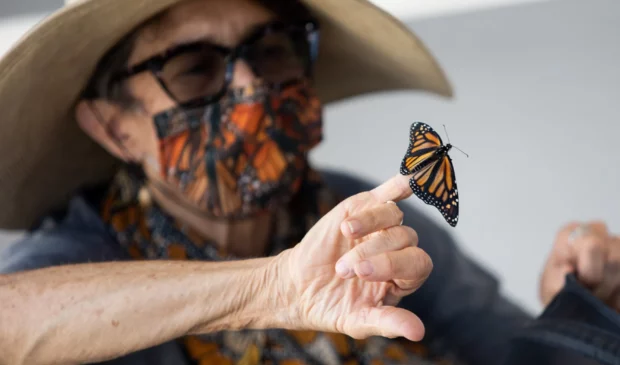Newsletter Signup
The Austin Monitor thanks its sponsors. Become one.
Most Popular Stories
- Austin’s airport is getting a new concourse and 20 more gates but not until the 2030s
- New rules in the works for electric vehicle charging stations
- Judge rules city can’t use taxpayer money for South Central TIRZ
- Budget deficit looms over city this year and beyond
- Save Our Springs Alliance sues City Council over Open Meetings Act
-
Discover News By District

Photo by Michael Minasi/KUT. Monika Maeckle, founder of the Monarch Butterfly and Pollinator Festival, releases a butterfly in San Antonio in October 2020. The annual festival was hosted online because of the pandemic.
Far fewer monarch butterflies are migrating through Texas this spring
Wednesday, April 12, 2023 by Mose Buchele, KUT
It’s the time of year when monarch butterflies pass through Texas on their annual migration. But you might not see as many as last spring. One reason? The number of monarchs that spent the winter in Mexico dropped significantly.
Migrating Eastern monarchs spend the winter months in forest colonies in the Mexican states of Michoacán and Mexico. Their population is tracked by the World Wildlife Fund, which measures it by surveying how much land is covered by thick masses of roosting insects. This winter’s survey found the butterflies concentrated on only about 5.5 acres of forest, a 22 percent decline from last winter.
“This is part of a mostly downward trend over the past 25 years, when monarchs once covered more than 45 acres of forest,” the WWF said in a press release.
That trend has many experts saying the Eastern monarch migration could eventually cease altogether.
The reasons for its general decline are many. They include habitat loss in the United States from farming and development, insecticide use, destruction of the monarchs’ winter grounds in Mexico, extreme weather and climate change.
But those challenges are no reason to give up hope that the population can’t rebound, says Monika Maeckle, who runs the website Texas Butterfly Ranch where she wrote about the spring migration.
Insect populations are “famously volatile,” she says, pointing out that the Eastern monarch population was up by 35 percent last year.
“The monarch butterfly population has been called bouncy,” she says. “(It goes) up and down, up and down. It just so often depends on conditions – climate, timing of the seasons, all that stuff.”
One reason for the butterflies’ lower numbers could be the devastating drought that began last year in Texas, depriving them of nectar and milkweed on which to lay their eggs and leading to fewer arriving in Mexico last fall.
That drought continues in much of the state, including San Antonio, where Maeckle tracks monarchs.
“I have not seen a lot of butterflies,” she says. “It’s been very dry, and it just really depends so much on where you are.”
Conservation, local and national
One way to encourage monarch migration is to plant the milkweed and flowers they rely on to eat and lay their eggs. Experts urge the use of native milkweed, though it can be more expensive and is difficult to grow.
Maeckle says local efforts to create monarch habitats in California could be one reason the population there rebounded after nearly disappearing. The Western population of butterflies was estimated to be 330,000 strong this winter. Fewer than 2,000 were counted there in 2020.
The U.S. Fish and Wildlife Service is also determining whether to list the species as threatened or endangered. In 2020, the agency determined listing the monarch was warranted, but did not proceed with a determination on how to regulate the species. It says the butterfly’s potential listing will be up for review again in 2024.
Listing monarchs as threatened or endangered would bring new regulatory protections to the species and its habitat. Depending on how the protections are written, however, listing could also complicate local monarch protection and propagation efforts. For example, a listing could potentially make it against the law for hobbyists to share monarch eggs or raise the species in their homes.
This story was produced as part of the Austin Monitor’s reporting partnership with KUT.
The Austin Monitor’s work is made possible by donations from the community. Though our reporting covers donors from time to time, we are careful to keep business and editorial efforts separate while maintaining transparency. A complete list of donors is available here, and our code of ethics is explained here.
You're a community leader
And we’re honored you look to us for serious, in-depth news. You know a strong community needs local and dedicated watchdog reporting. We’re here for you and that won’t change. Now will you take the powerful next step and support our nonprofit news organization?









